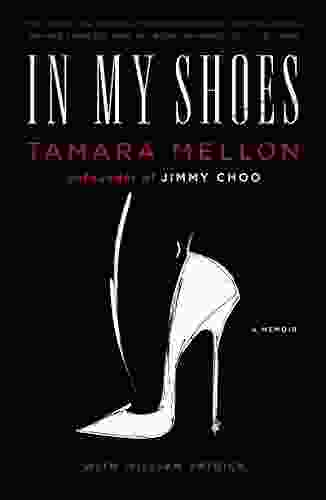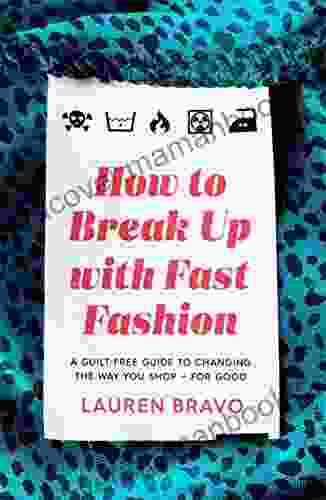How to Break Up with Fast Fashion: A Comprehensive Guide to Sustainable Style

Fast fashion, characterized by its rapid production cycles and low prices, has become a major player in the global fashion industry. However, this convenience comes at a great cost to the environment and to the people who make our clothes.
The environmental impact of fast fashion is staggering. The industry is responsible for up to 10% of global carbon dioxide emissions, more than international flights and shipping combined. It also consumes vast amounts of water and energy, and generates millions of tons of textile waste each year.
The social impact of fast fashion is equally troubling. Workers in the garment industry are often paid poverty wages and work in dangerous conditions. They are also subject to long hours and unpaid overtime.
4.7 out of 5
| Language | : | English |
| File size | : | 2011 KB |
| Text-to-Speech | : | Enabled |
| Screen Reader | : | Supported |
| Enhanced typesetting | : | Enabled |
| X-Ray | : | Enabled |
| Word Wise | : | Enabled |
| Print length | : | 233 pages |
If you're concerned about the impact of fast fashion, there are things you can do to make a difference. One of the most important things you can do is to break up with fast fashion and embrace sustainable style.
Sustainable style is a way of dressing that takes into account the environmental and social impact of clothing production. It involves choosing clothes that are made from sustainable materials, that are produced in an ethical way, and that will last for a long time.
There are many different ways to practice sustainable style. Some people choose to buy only clothes that are made from organic or recycled materials. Others choose to buy clothes from brands that are committed to ethical production practices. And still others choose to buy fewer clothes overall and to invest in pieces that will last.
No matter how you choose to practice sustainable style, the important thing is to make choices that are mindful of the impact that your clothing has on the planet and on the people who make it.
Breaking up with fast fashion can be challenging, but it's definitely possible. Here are a few tips to help you get started:
- Start by making small changes. You don't have to go cold turkey and give up all of your fast fashion clothes overnight. Start by making small changes, such as buying one less fast fashion item per month or choosing to buy clothes from sustainable brands.
- Do your research. Before you buy any new clothes, take some time to do your research and learn about the brands and the materials that they use. This will help you make more informed choices about what you buy.
- Invest in quality over quantity. Fast fashion clothes are often made from cheap materials that are not designed to last. Instead of buying a lot of cheap clothes, invest in a few high-quality pieces that will last for years to come.
- Buy clothes that fit well. Clothes that fit well will last longer and look better. When you buy clothes that are too big or too small, they are more likely to get damaged or to end up in the landfill.
- Take care of your clothes. Once you have invested in a few quality pieces, take good care of them. This means washing them less frequently, using cold water and gentle detergents, and hanging them to dry.
- Repair your clothes. If your clothes get damaged, don't throw them away. Instead, try to repair them. There are many resources available online and in your community that can help you learn how to repair clothes.
- Donate or recycle your clothes. When you are finished with your clothes, don't throw them away. Instead, donate them to a charity or recycle them. There are many organizations that accept clothing donations, and there are also many ways to recycle clothes.
There are many benefits to adopting a sustainable style. For one, it's better for the environment. Sustainable clothes are made from materials that are less harmful to the planet, and they are produced in a way that conserves resources.
Second, sustainable style is better for the people who make our clothes. Workers in the garment industry are paid fair wages and work in safe conditions when they produce sustainable clothes.
Third, sustainable style is better for your wallet. Sustainable clothes are often more expensive than fast fashion clothes, but they will last longer and look better. This means that you will save money in the long run.
Finally, sustainable style is simply more stylish. Sustainable clothes are made from high-quality materials and are designed to last. They are also often more unique and interesting than fast fashion clothes.
Breaking up with fast fashion is not easy, but it's definitely possible. By making small changes, ng your research, and investing in quality over quantity, you can adopt a sustainable style that is better for the environment, for the people who make our clothes, and for your wallet.
So what are you waiting for? Break up with fast fashion today and embrace sustainable style!
4.7 out of 5
| Language | : | English |
| File size | : | 2011 KB |
| Text-to-Speech | : | Enabled |
| Screen Reader | : | Supported |
| Enhanced typesetting | : | Enabled |
| X-Ray | : | Enabled |
| Word Wise | : | Enabled |
| Print length | : | 233 pages |
Do you want to contribute by writing guest posts on this blog?
Please contact us and send us a resume of previous articles that you have written.
 Top Book
Top Book Novel
Novel Fiction
Fiction Nonfiction
Nonfiction Literature
Literature Paperback
Paperback Hardcover
Hardcover E-book
E-book Audiobook
Audiobook Bestseller
Bestseller Classic
Classic Mystery
Mystery Thriller
Thriller Romance
Romance Fantasy
Fantasy Science Fiction
Science Fiction Biography
Biography Memoir
Memoir Autobiography
Autobiography Poetry
Poetry Drama
Drama Historical Fiction
Historical Fiction Self-help
Self-help Young Adult
Young Adult Childrens Books
Childrens Books Graphic Novel
Graphic Novel Anthology
Anthology Series
Series Encyclopedia
Encyclopedia Reference
Reference Guidebook
Guidebook Textbook
Textbook Workbook
Workbook Journal
Journal Diary
Diary Manuscript
Manuscript Folio
Folio Pulp Fiction
Pulp Fiction Short Stories
Short Stories Fairy Tales
Fairy Tales Fables
Fables Mythology
Mythology Philosophy
Philosophy Religion
Religion Spirituality
Spirituality Essays
Essays Critique
Critique Commentary
Commentary Glossary
Glossary Bibliography
Bibliography Index
Index Table of Contents
Table of Contents Preface
Preface Introduction
Introduction Foreword
Foreword Afterword
Afterword Appendices
Appendices Annotations
Annotations Footnotes
Footnotes Epilogue
Epilogue Prologue
Prologue W J Herbert
W J Herbert David Kinch
David Kinch Nicolas Leonard
Nicolas Leonard Dionne Haynes
Dionne Haynes Lauren Bravo
Lauren Bravo Ralph Manheim
Ralph Manheim Eduardo De Filippo
Eduardo De Filippo Vladimir Mayakovsky
Vladimir Mayakovsky Richard Benson
Richard Benson Jeremy Taylor
Jeremy Taylor Gerard Way
Gerard Way Cedric Kelly
Cedric Kelly Sax Rohmer
Sax Rohmer Gonzalo Sanabria
Gonzalo Sanabria Keith Taylor
Keith Taylor Kathrine Mortimore
Kathrine Mortimore Wendi Friesen
Wendi Friesen Dan Hampton
Dan Hampton S Theresa Dietz
S Theresa Dietz Camila Hurst
Camila Hurst
Light bulbAdvertise smarter! Our strategic ad space ensures maximum exposure. Reserve your spot today!

 Connor MitchellUnveiling the Intriguing World of The Evil Lord of an Intergalactic Empire:...
Connor MitchellUnveiling the Intriguing World of The Evil Lord of an Intergalactic Empire:...
 F. Scott Fitzgerald10 Principles That Propulsed Me to Financial Success: A Guide for Your Own...
F. Scott Fitzgerald10 Principles That Propulsed Me to Financial Success: A Guide for Your Own...
 Isaiah PowellAriette From Romeo and Juliet: A Comprehensive Exploration of Her Role and...
Isaiah PowellAriette From Romeo and Juliet: A Comprehensive Exploration of Her Role and... Vernon BlairFollow ·18.9k
Vernon BlairFollow ·18.9k Jamie BlairFollow ·5.2k
Jamie BlairFollow ·5.2k Jamie BellFollow ·9k
Jamie BellFollow ·9k Jerry HayesFollow ·10.5k
Jerry HayesFollow ·10.5k David PetersonFollow ·18.3k
David PetersonFollow ·18.3k Luke BlairFollow ·13.8k
Luke BlairFollow ·13.8k Guillermo BlairFollow ·4k
Guillermo BlairFollow ·4k Ron BlairFollow ·14.8k
Ron BlairFollow ·14.8k

 Eugene Powell
Eugene PowellComplete Guide to Using Yoga With Kids: Benefits, Tips,...
Yoga is an ancient practice that has been...

 Benji Powell
Benji PowellHow to Make $000 Per Week on Craigslist
Are you looking for a way to make extra money...

 Gabriel Garcia Marquez
Gabriel Garcia MarquezGrocery Row Gardening: The Exciting New Permaculture...
Kick-start your gardening journey with the...

 Hayden Mitchell
Hayden MitchellUnveiling the Gripping World of Winterwood: Ben Hood...
In the annals of crime thrillers, the...

 E.M. Forster
E.M. ForsterThe Financial Advisor Guide To Managing and Investing...
As a financial...

 Lee Simmons
Lee SimmonsIn My Shoes Memoir: A Poignant Journey of Resilience,...
In the tapestry of life, adversity often...
4.7 out of 5
| Language | : | English |
| File size | : | 2011 KB |
| Text-to-Speech | : | Enabled |
| Screen Reader | : | Supported |
| Enhanced typesetting | : | Enabled |
| X-Ray | : | Enabled |
| Word Wise | : | Enabled |
| Print length | : | 233 pages |





